The next-gen MacBook Pro with Retina Display Review
by Anand Lal Shimpi on June 23, 2012 4:14 AM EST- Posted in
- Mac
- Apple
- MacBook Pro
- Laptops
- Notebooks
GPU Performance
We’ve already established that NVIDIA’s Kepler architecture is fast, but the GeForce GT 650M used in the rMBP is hardly the best NVIDIA has to offer. The result however is a significant improvement in performance over the Radeon HD 6750M used in the previous generation model.
| 15-inch MacBook Pro Model | Mid 2010 | Upgraded Early 2011 | Upgraded Late 2011 | Retina |
| GPU | GeForce GT 330M | Radeon HD 6750M | Radeon HD 6770M | GeForce GT 650M |
| Cores | 48 | 480 | 480 | 384 |
| Core Clock | 500MHz | 600MHz | 675MHz | 900MHz |
| Memory Bus | 128-bit GDDR3 | 128-bit GDDR5 | 128-bit GDDR5 | 128-bit GDDR5 |
| Memory Data Rate | 1580MHz | 3200MHz | 3200MHz | 5016MHz |
| Memory Size | 512MB | 1GB | 1GB | 1GB |
The GT 650M offers fewer “cores” compared to the 6750M and 6770M used in previous MacBook Pros, but likely better utilization of the available hardware. NVIDIA also clocks the cores much higher in the 650M, the result is a ~20% increase in theoretical raw compute power.
The memory bandwidth story is also better on Kepler. While both the GT 650M and the 67xxM feature a 128-bit GDDR5 interface, Apple clocked AMD’s memory interface at 800MHz compared to 1254MHz on Kepler. The resulting difference is 80.3GB/s of memory bandwidth vs. 51.2GB/s.
The real world impact is most noticeable at higher resolutions, thanks to the tremendous amount of memory bandwidth now available. The other benefit from the new GPU is obviously things run a lot cooler, which as I’ve already shown to considerably reduce thermal throttling under load.
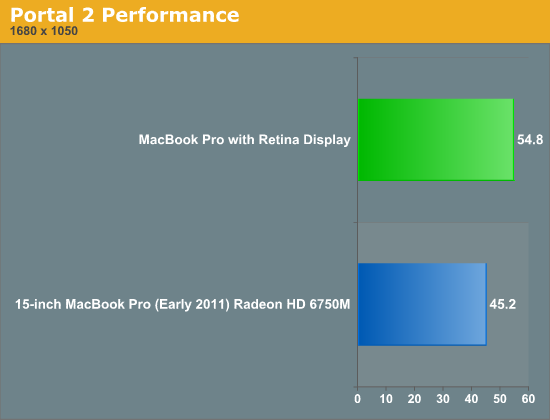
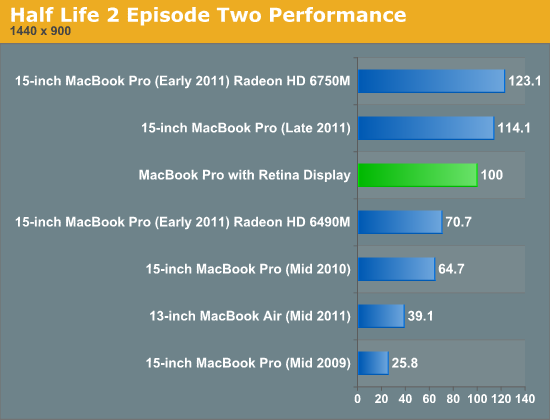
At 1440 x 900 we actually see a regression compared to the 2011 models, but differences in the AMD and NVIDIA GPU drivers alone can account for the difference at this hardly GPU bound setting. Look at what happens once we crank up the resolution:
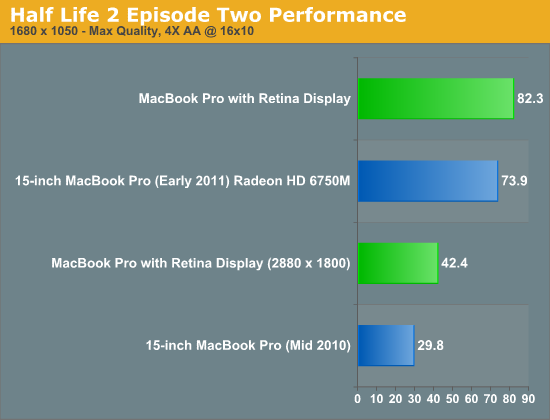
At 1680 x 1050 with 4X AA enabled we see a modest 11% increase in performance over last year's MacBook Pro. As I established earlier however, the rMBP will be able to more consistently deliver this performance over an extended period of time.
What's even more impressive is the 42.4 fps the GT 650M is able to deliver at the rMBP's native 2880 x 1800 resolution. Even though I ran the test with AA enabled I'm pretty sure AA was automatically disabled. At 2880 x 1800 the rMBP is able to outperform the two year old MacBook Pro running at 1680 x 1050. How's that for progress?
While the gains we've shown thus far have been modest at best, Starcraft 2 is a completely different story. Here for whatever reason the IVB + Kepler combination can be up to 2x the speed of last year’s models. I reran the tests both on the older and rMBP hardware to confirm, but the results were repeatable. The best explanation I have is Starcraft 2 is very stressful on both the CPU and GPU, so we could be seeing some thermal throttling on the older SNB + Turks hardware here.
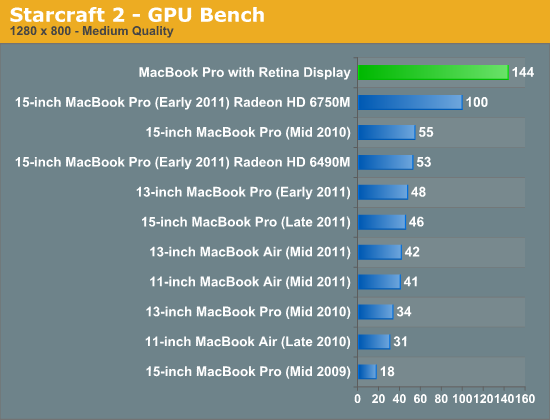
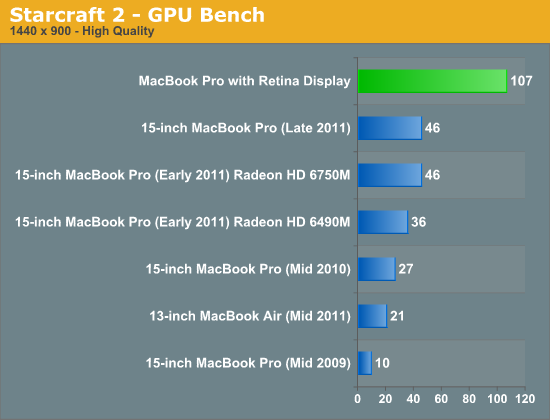
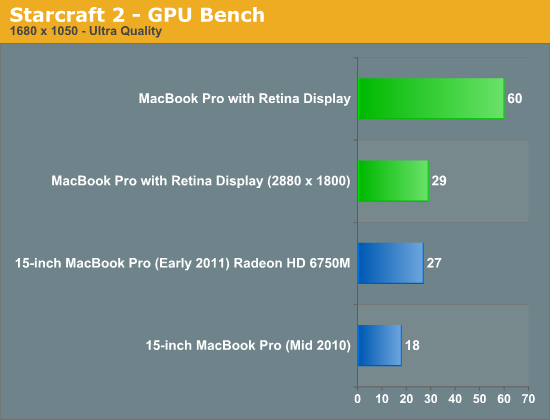
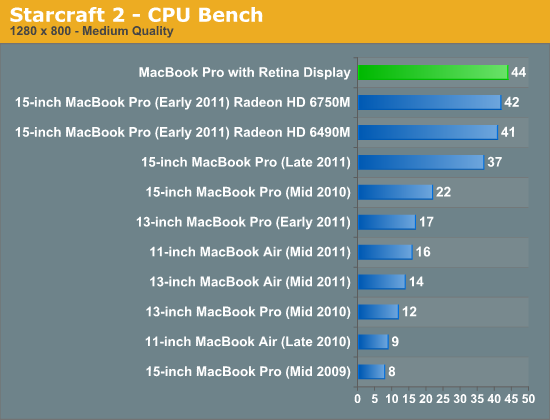
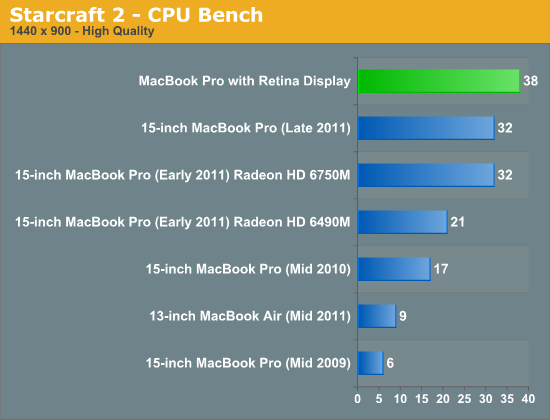

Once again we see playable, although not entirely smooth frame rates at 2880 x 1800. I've also included a screenshot of SC2 at 2880 x 1800 below:
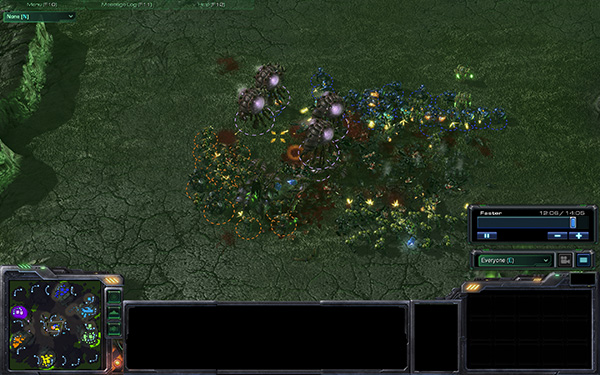
Starcraft 2 at 2880 x 1800, it's playable
Although gaming options continue to be limited under OS X, Diablo 3 is available and finally performs well on the platform thanks to the latest patches. Diablo 3 performance is appreciably better on the GT 650M compared to last year’s 6750M. There’s no FRAPS equivalent under OS X (free advertising to the first eager dev to correct that) so I have to rely on general discussion of performance here. The GT 650M is fast enough to drive the rMBP’s 2880 x 1800 panel at native resolution at playable frame rates, around 18 fps on average. Connected to an external 2560 x 1440 display however the GT 650M is fast enough to deliver around 30 fps in Diablo 3. For what it’s worth, performance under Diablo 3 is far more consistent with the rMBP than with last year’s MacBook Pro. I suspect once again we’re seeing the effects of thermal throttling under heavy CPU/GPU load that has been well mitigated by the move to more power efficient silicon.



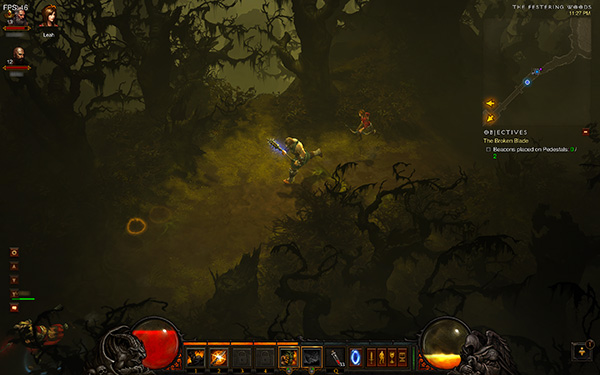








471 Comments
View All Comments
orthorim - Wednesday, June 27, 2012 - link
A very high resolution display is not a retina display - totally different thing.Retina is a special mode where each logical pixel is made up of 4 physical pixels, and special support for fonts and images.
It's a huge step to go from 1:1 logical : physical pixels to a different factor. It's like bitmap based fonts vs. points-based vector fonts.
Maybe a lot of PC manufacturers just don't get that?
vegemeister - Monday, July 2, 2012 - link
Apple is not using a PPI independent UI for their high-res displays though. There's a separate set of assets at 2x resolution, and programs that don't acknowledge that they're rendering at 2x resolution get upscaled.A real PPI independent UI, such as Gnome 2, uses vector resources for everything and allows applications to query the PPI of the display so they can render at appropriate dimensions.
maraboshi - Saturday, June 30, 2012 - link
and still that was FAIL because it runs Windows and not a brilliant OS like the Apple one...when will you stupid Apple haters will understand the fucking difference?????gbanfalvi - Sunday, July 1, 2012 - link
I have it. It's a piece of crap. It feels like they just stuffed everything they could in this device without thinking.The pads on the bottom fell of from the heat.
The battery died seven months in.
The trackpad starts glitching regularly (not to mention it's terrible in general).
The 1080p screen gets lines across it.
The laptop overheats when I put it in speed mode.
Evidence: https://dl.dropbox.com/u/245279/Photos/Photo%20201...
azaat07 - Friday, July 13, 2012 - link
Hole in your hyperbole...Only option is Intel Graphics 4000, shared memory.
Intel 4k graphics are on par with 2007 discrete.
Andrew
woodsielord - Sunday, July 15, 2012 - link
I have the said computer. I bought it with very high expectations, and the screen is still amazing, but the rest of the hardware keeps causing trouble. I have lived without my computer 3+ months due to repairs, and currently I'm typing this from my girlfriend's Zenbook (which, on the other hand, is zero problems and all play).The lack of international Sony support and the proclimity to hardware failure rule out Sony of all my future purchases. Many times I said to myself that I should have bought a MBP instead. If Sony stopped spewing forth so many products and instead tended to the details of flagship products and cared about its customers, it might have worked.
mark3785 - Saturday, September 8, 2012 - link
Ok, I'll play the fanboy…This is where Apple haters really get pissed (and as an Apple fan from the mid 80s (and a loyalist from the 90 days from bankruptcy days) (if I'm playing the fanboi thing I may as well go whole hog) I really start to chuckle).
The MacBook Pro with retina display is proof positive that Apple can do things that the windows community can't because Apple has control of both sides of the coin, the hardware and the OS, plus (and this is a really huge plus) they have some very smart people working for them. It's one thing to put a hires display on a computer and an entirely different thing to make that display resolution independent. Sony may have come out with a hires laptop back in 2010, but they didn't do anything interesting with it.
Eventually 2880x1800 will be run of the mill and higher resolutions will start to dominate. It isn't the number of pixels, it's how the system uses them to it's best advantage. This is (hopefully) the beginning of a new trend.
BTW, one helluva review! Reviews are boring, though comforting when they state the obvious (yes, you bought a nifty machine, pat on the head) but a review this informative and complete just reinvigorates my interest in the hobby.
Targon - Saturday, June 23, 2012 - link
You need to look at the different price points that machines are sold for before you make statements like that. Most manufacturers see far greater volumes in the $500 range than they see in the $1500+ range, and it is that range that the majority of consumers look when it comes to buying a computer, either desktop or laptop.The area that manufacturers SHOULD be moving in is to make the move to a 1920x1080 display across their entire range of 14 inch and greater machines as the norm, rather than as an extra feature that people need to pay extra for if you are in the $450+ price range. Higher resolutions should be offered as the norm for higher end laptop displays. Until that happens, the PC side of the industry will seem to be inferior when it comes to display technology.
If you think about it, display technologies have been fairly stagnant except from Apple, and we have not seen an aggressive attempt to improve what we see out there. 1920x1080 displays have been the norm for too long, and going to 1920x1200 isn't enough.
OCedHrt - Sunday, June 24, 2012 - link
Check out the new Sony TTvegemeister - Monday, July 2, 2012 - link
1920x1080 should be the norm for 11".